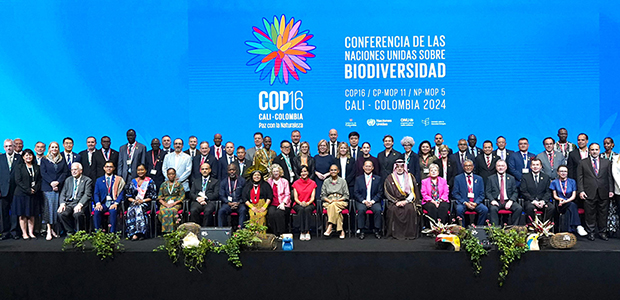COP16, held in Cali, Colombia, under the theme Peace with Nature, made significant strides in turning the Kunming-Montreal Global Biodiversity Framework (GBF) into action. Here are 10 key solutions and initiatives highlighted at COP16, with insights from notable participants and organizations:
1. Roadmap for Kunming-Montreal GBF Implementation
A major outcome was the adoption of a roadmap to operationalize the Kunming-Montreal GBF, aiming to reverse biodiversity loss by 2030. Colombian Environment Minister Susana Muhamad called it “a historic turning point for practical action,” emphasizing collaboration between nations to achieve conservation goals.
2. Elevating Nature-Based Solutions (NBS)
Nature-Based Solutions (NBS) were established as central to addressing biodiversity and climate issues. Inger Andersen, Executive Director of the UN Environment Programme (UNEP), stated, “NBS are essential tools that offer scalable and cost-effective climate mitigation while enhancing biodiversity.” Projects like reforestation initiatives led by the International Union for Conservation of Nature (IUCN) were highlighted for their dual benefits.
3. Indigenous and Local Community Leadership
Indigenous and local community engagement was a crucial focus. Astrid Schomaker, Executive Secretary of the Convention on Biological Diversity (CBD), noted, “Without the knowledge and leadership of Indigenous communities, global conservation efforts would fall short.” COP16 reinforced the importance of integrating traditional knowledge into conservation practices, supported by organizations such as WWF.

4. High-Integrity Carbon Market Standards
Strengthening carbon markets to ensure high-integrity natural climate solutions was a significant topic. Antonio Guterres, UN Secretary-General, underscored, “We must guard against greenwashing by demanding rigorous standards that ensure carbon markets genuinely contribute to both climate and biodiversity goals.” This call was backed by organizations like the Taskforce on Scaling Voluntary Carbon Markets.
5. Increased Financial Support for Developing Nations
Commitments to enhancing financial support mechanisms for developing nations were highlighted as essential for equitable global progress. The Global Environment Facility (GEF) pledged new funding pathways to enable countries in the Global South to lead biodiversity projects. Colombia’s Vice President Francia Márquez pointed out, “These funds will empower local communities to implement impactful conservation strategies without facing economic penalties.”
6. Focus on Marine Ecosystem Conservation
COP16 broadened its conservation focus to include marine ecosystems. Susan Lieberman of the Wildlife Conservation Society remarked, “Healthy oceans are not just an environmental concern; they are a climate necessity.” Agreements were made to protect marine biodiversity, reduce pollution, and strengthen coastal resilience, building on past frameworks like the Kunming-Montreal GBF.
7. Integration of Biodiversity into Net-Zero Plans
The integration of biodiversity into net-zero plans was emphasized through reports like Nature in Net-Zero Transition Plans by GFANZ. Mark Carney, Co-Chair of GFANZ, noted, “Financial institutions must move beyond traditional climate metrics to include biodiversity targets to ensure sustainability.” This approach aligns with findings from the Intergovernmental Science-Policy Platform on Biodiversity and Ecosystem Services (IPBES), which advocates for nature-centric climate solutions.
8. Advancing Cross-Sector Collaboration Initiatives
Cross-sector partnerships were stressed as vital for scalable biodiversity action. Partnerships between UNEP, the World Bank, and various NGOs were spotlighted as models for aligning economic interests with conservation efforts. UNEP’s Inger Andersen highlighted, “Collaboration between public and private sectors will be the cornerstone of meaningful progress.”
9. Commitments to Transparent Global Reporting
To ensure accountability, COP16 participants agreed on the adoption of a unified biodiversity reporting framework. The Nature-Based Solutions Initiative reported that this step would enhance transparency and allow consistent tracking of progress. Elizabeth Maruma Mrema, Deputy Executive Director of UNEP, added, “Clear and consistent reporting is the foundation for real progress.”
10. Promotion of Urban Biodiversity and Green Infrastructure
Urban centers were urged to integrate green infrastructure to support biodiversity and mitigate climate impacts. Pippa Howard, Chief Nature Strategy Officer at NatureMetrics, noted that “urban biodiversity can transform cities into ecosystems that support both people and wildlife.” This aligns with initiatives encouraging cities to adopt nature-positive strategies.
Climate Insider Notes
- The roadmap for the Kunming-Montreal GBF is set to accelerate biodiversity action toward 2030 goals.
- Nature-Based Solutions were prominently featured, linking climate resilience and biodiversity.
- Indigenous leadership and inclusive policies were highlighted as non-negotiable for lasting change.
- The emphasis on transparent reporting and public-private partnerships underscores the holistic approach needed for global conservation success.
These outcomes from COP16 signal a shift toward integrated biodiversity and climate action, essential for sustainable global development.
Featured Image: Credit: Environmental Finance








